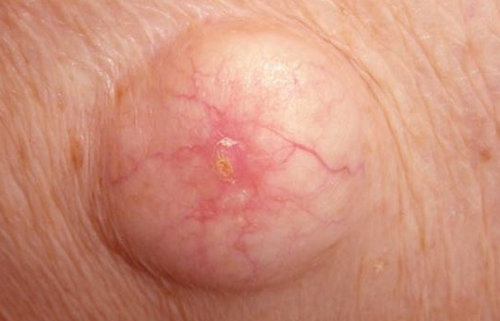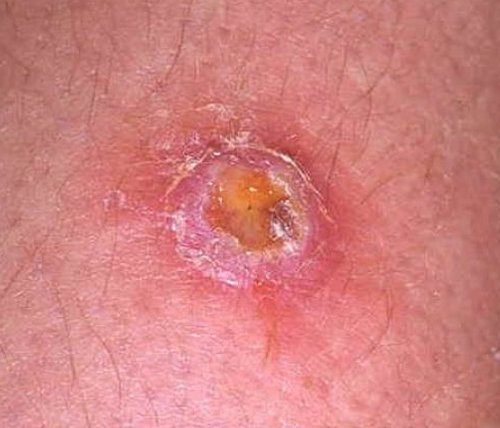Ingrown Hair Cyst
An ingrown hair pertains to the backward curling of hair into the skin or on the surface of the skin that develops into small swelling-like pimples.
The condition is called ingrown hair cyst. An ingrown hair cyst affects the hair follicle. It is known for other names like folliculitis, pilar and isthmus-catagen cyst.
Can a simple ingrown hair turn into a cyst? Well, it all starts with an infection. The ingrown hair begins to pop discharges causing to pain and discomfort. It is important to get rid of the cyst as soon as possible to avoid worsening of the condition.
If it gets infected with bacteria, the cyst will be filled up with pus that is yellow or green in color (1). The cyst appears as a large lump or boils. It affects various parts of the body such as:
- Face
- Bikini
- Armpit
- Groin
- Inner thigh
- Scalp
- Penile shaft
- Under the chin
How long does an ingrown hair last?
An ingrown hair appears after a few days after a close shave or other methods of hair removal. It starts with a small bump on the skin that looks like a pimple. You can see the trapped hair within the bump. Ingrown hair usually goes away after the hair grows out naturally. It can last for a few days to several weeks. There will be a mild discomfort but it can be eased with warm compress. (2, 3)
What are the causes of ingrown hair cyst?
- Excessive drying of the skin
- Improper shaving techniques.
- Diseases involving the hair follicle
- Hormonal imbalance
- Bacterial or fungal infection
- Cystic acne
- Clogged pores
- Improper waxing technique
- Curly hair
- High sex hormone level which could lead to increased hair growth
What are the symptoms?
- Itching
- The skin becomes tender
- Bump
- Bruises around the cyst
- Inflammation
- A fluid sac that appears yellow or white. When the color turns to green, it means that it is already infected.

Image 1 : An image of an ingrown hair cyst
Photo Source : www.treatcurefast.com

Picture 2 : An image of an infected ingrown hair cyst
Photo Source : usercontent2.hubstatic.com
How to get rid of ingrown hair cyst at home?
- Tea tree oil – It is one of the natural treatments for ingrown hair cysts. It can help get rid of the infection because of its anti-inflammatory and antibacterial property. Add a few drops of the oil to a little water. Use the solution to clean the affected area every day. Leave the solution for a few minutes and rinse with lukewarm water.
- Aloe Vera – This plant has long been used for maintaining hair and skin health. Put a few drops of aloe vera to the cyst to help fight the infection and speed up the healing process.
- Warm Water – If you don’t have aloe vera or tea tree oil at home, then you can use warm water to relieve the redness, swelling, and pain. Do this once you notice the onset of the infection. It is important to detect the infection right away to start the treatment and prevent worsening of the condition. (3, 4)
Advanced treatment methods for ingrown hair cyst - Prescription creams – Dermatologists usually recommend steroids to alleviate the pain, swelling, and itching. A topical steroidal cream alleviates mild to moderate inflammation. It also reduces itching and irritation. For severe cases, the best option is oral corticosteroid such as prednisolone and hydrocortisone. Corticosteroids have side effects and so it should only be used upon the prescription of your doctor.
- Antibiotic pills (5) – If you use prescription creams and there are side effects, the doctor usually recommends antibiotic pills. An antibiotic cream can be prescribed too depending on the severity of the condition of the patient.
Pain medications – Ingrown hair cyst can be painful, especially in severe cases. The pain is intense if the cyst is located in areas like armpit and pubic area. To alleviate the pain, you should take over the counter pain medication like ibuprofen. A high dose of pain killer should be used for intense pain. However, you will need prescription from your doctor as high dose pain killers cannot be purchased over the counter. - Tretinoin (4) – It is a form of vitamin A, which helps renew the skin cells. It reduces skin plugging and gets rid of accumulation of dirt and dead skin cells thereby reducing the chances of ingrown hair cyst.
- Injections – If the cyst is infected, an injection is given to prevent worsening of the condition. Not receiving the right treatment could lead to secondary infection. Patients are usually given an injection of antibacterial solution or retinoid solution.
- Anti-acne drugs – Acne creams help in preventing the formation of scars. Most anti-acne drugs contain salicylic acid, which helps exfoliate the skin. It dries out the cyst and eventually get rid of it with long term use.
Surgical approach
When all other treatment methods fail, the last resort is surgery. Ingrown hair cyst, especially if large in size can cause aesthetic discomfort. Hence, it should be removed through surgical approach. Other way of removing it is through laser surgery technique.
It will be a minor operation and can be done in the clinic of the surgeon. The doctor will use local anesthesia and will make incision. When filled with pus, the surgeon will drain the pus to get rid of all the content. (3)
New treatment approach for ingrown hair cyst
The argon laser is a new treatment approach for removing ingrown hair cyst. It uses ionized argon as an active medium. Its goal is to photocoagulate. The laser coagulates the undesired hair and skin. It targets the hair follicle and destroys the roots. This method is highly effective and does not cause damage to the surrounding tissues. (1, 2)
What you can do to prevent ingrown hair cyst?
- When shaving, make sure you are going to use clean and sharp razors. Observe the proper shaving technique.
- If you have a sensitive skin or super soft skin, you have to apply a cream or skin conditioner prior to shaving for easier hair removal.
- Avoid shaving against the grain. The direction of your shave should be into the direction of the hair growth.
- Keep the razor clean before and after use. By doing so, you will be able to avoid build-up of infection-causing microorganism.
- As much as possible, use fewer stroke when shaving.
- Make it a habit to exfoliate your skin to get rid of dead skin cells that may cause the hair to be clogged beneath the skin’s surface.
- You should keep the skin clean at all times.
- Do not scratch the skin using your nails, especially when the irritation occurs after shaving.
- You should avoid wearing too tight clothing to reduce curling of the hair that could lead to ingrown hair cyst. (7, 8)
References:
- https://medlicker.com
- www.healcure.org
- www.lightskincure.org
- dailyknowledgetree.com
- www.wowremedies.com
- www.healtreatcure.org
- www.healtholino.com
- www.tandurust.com